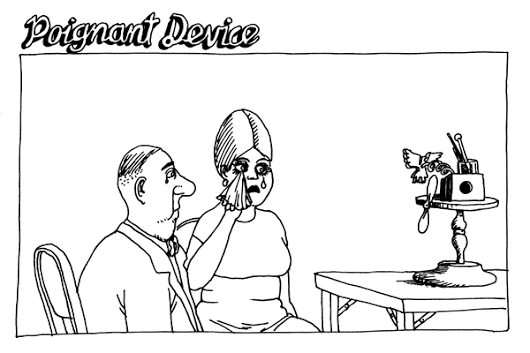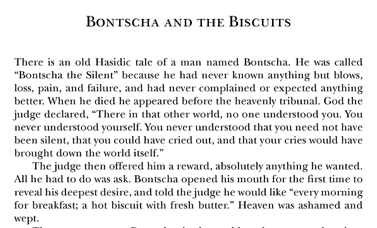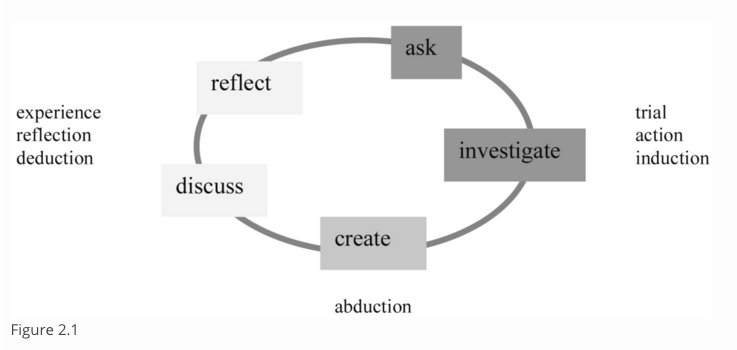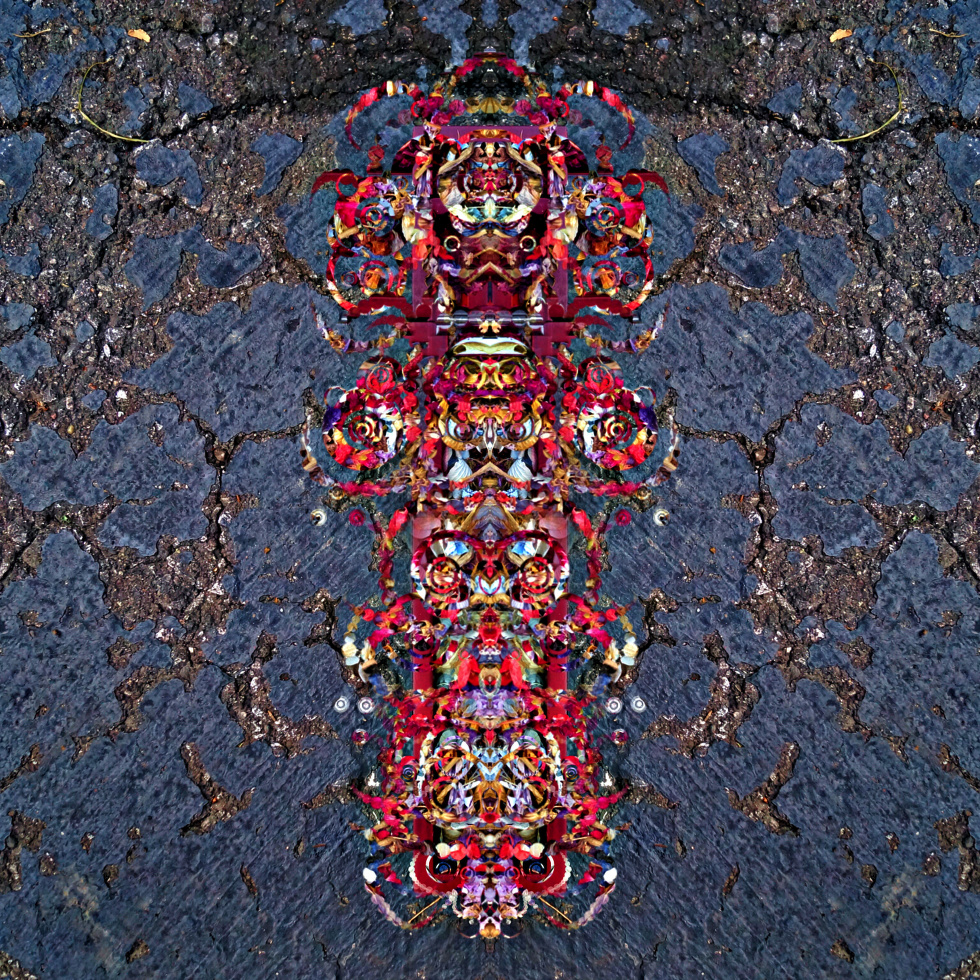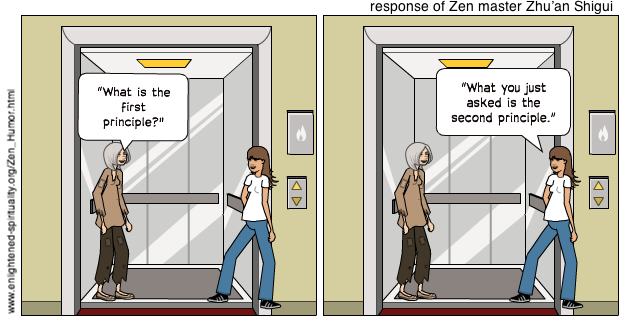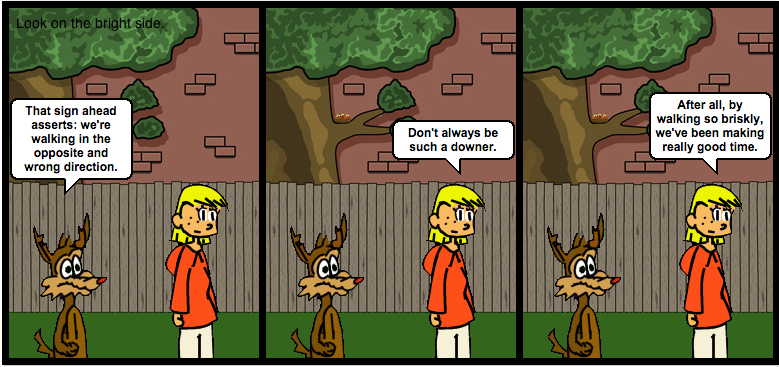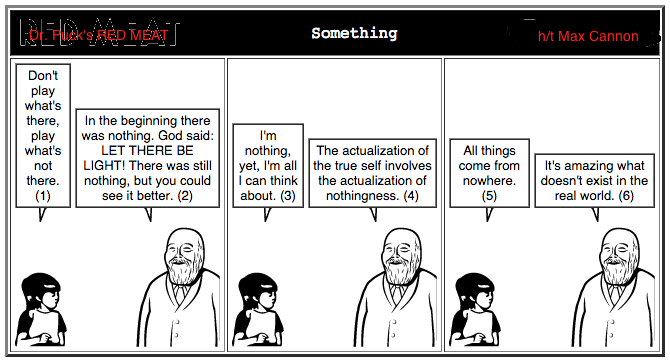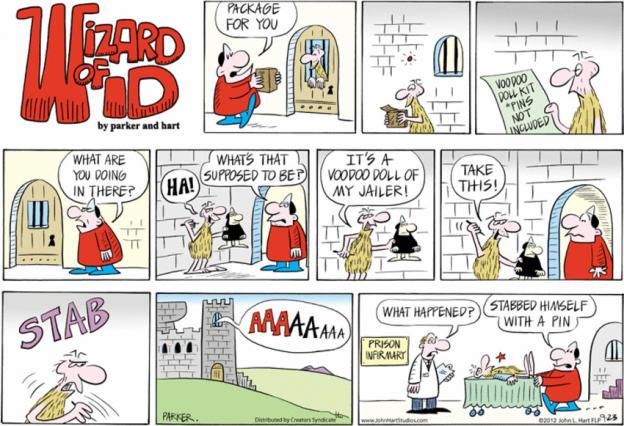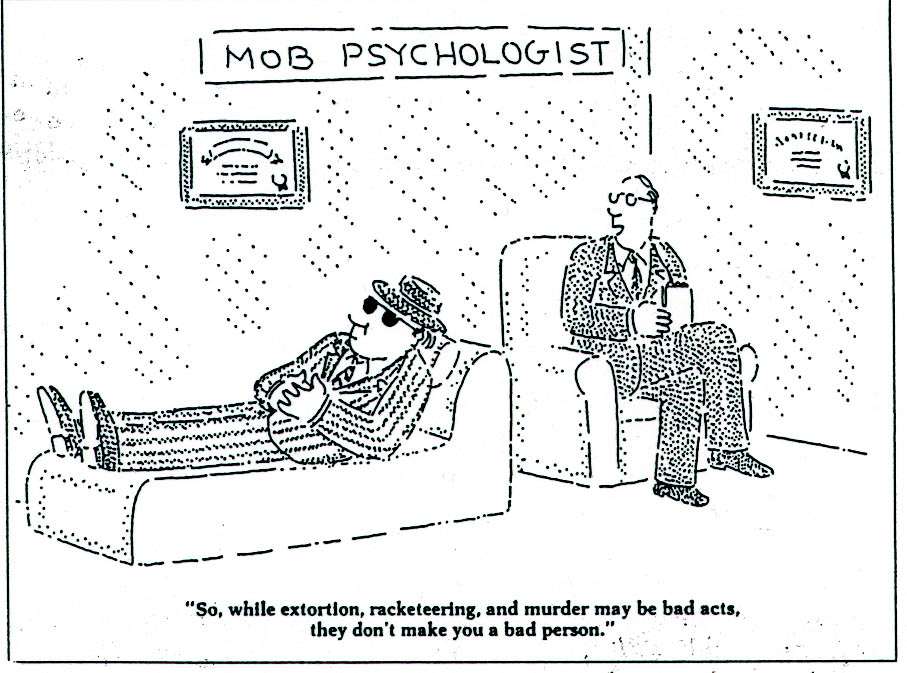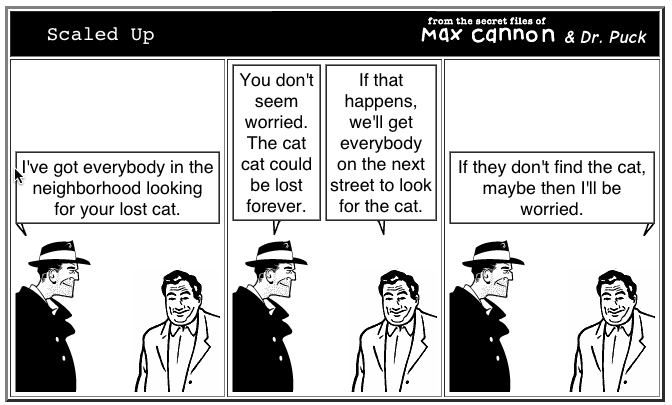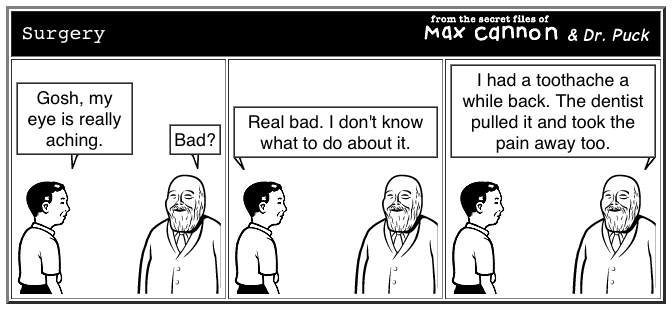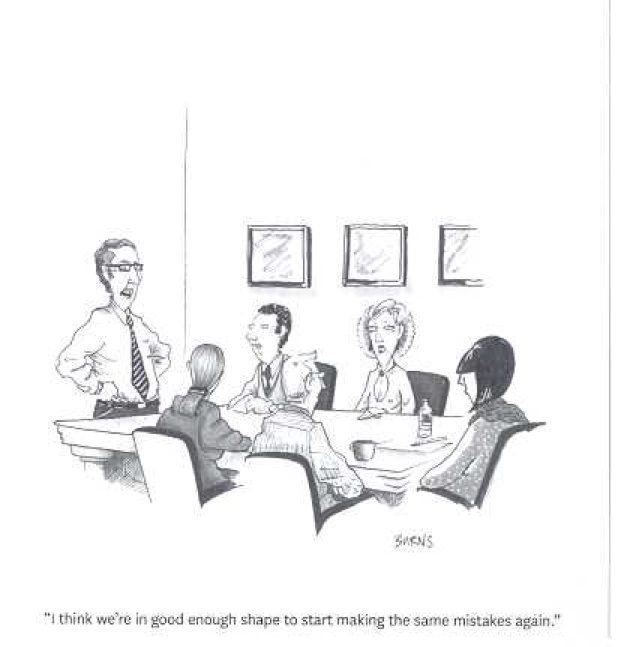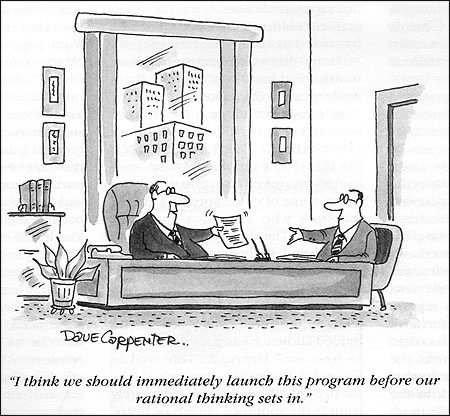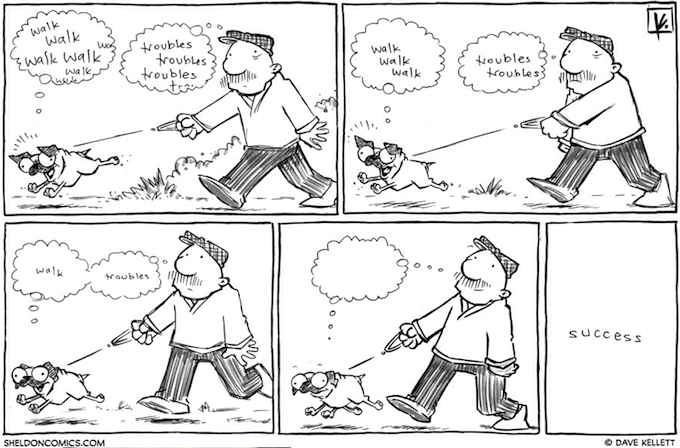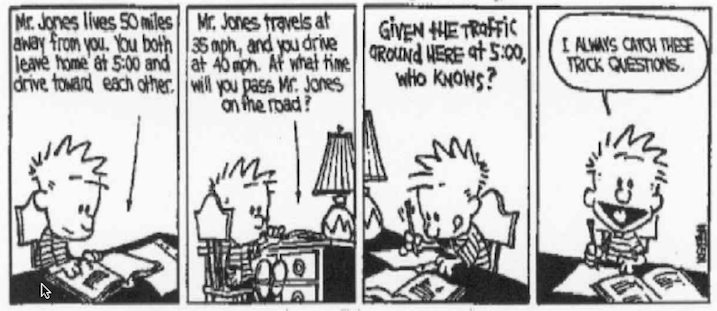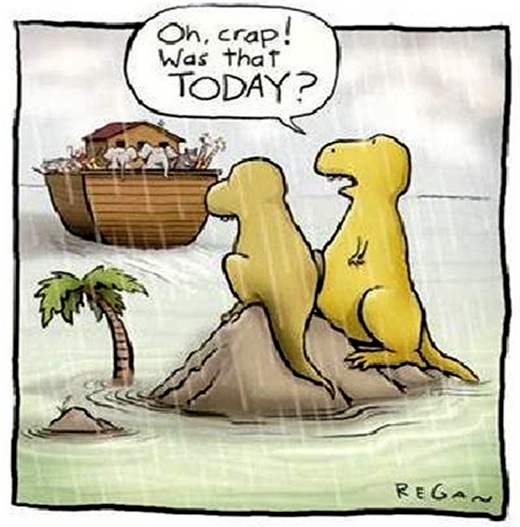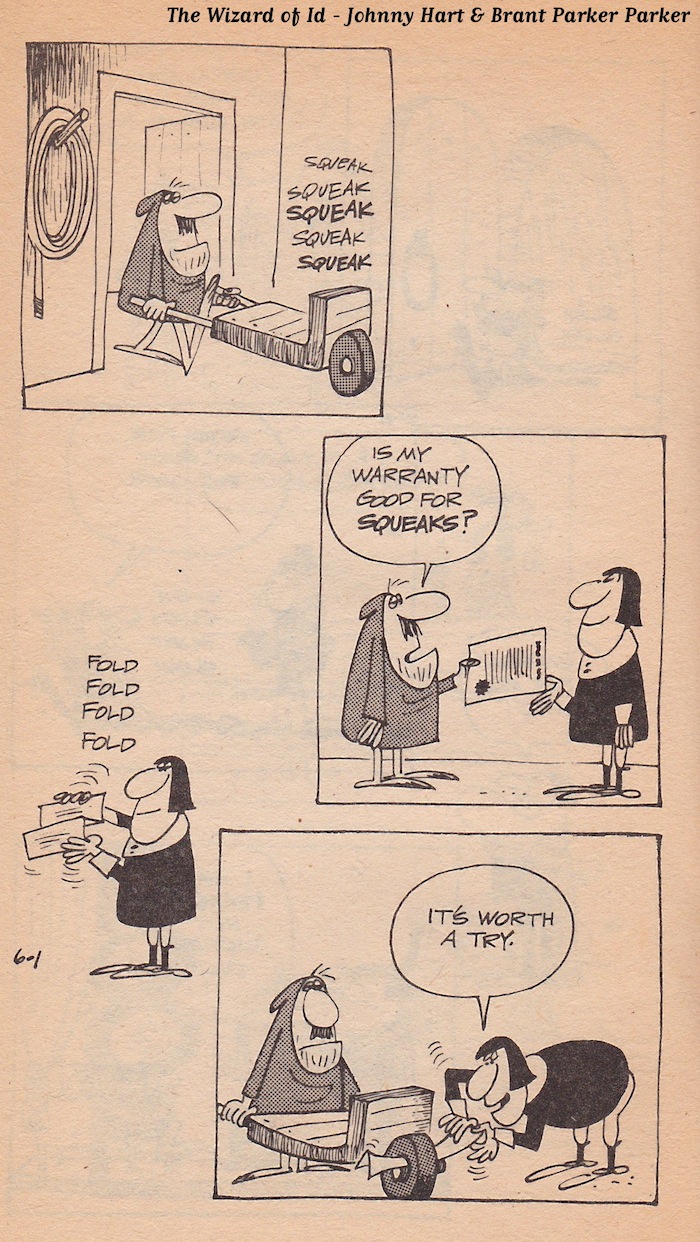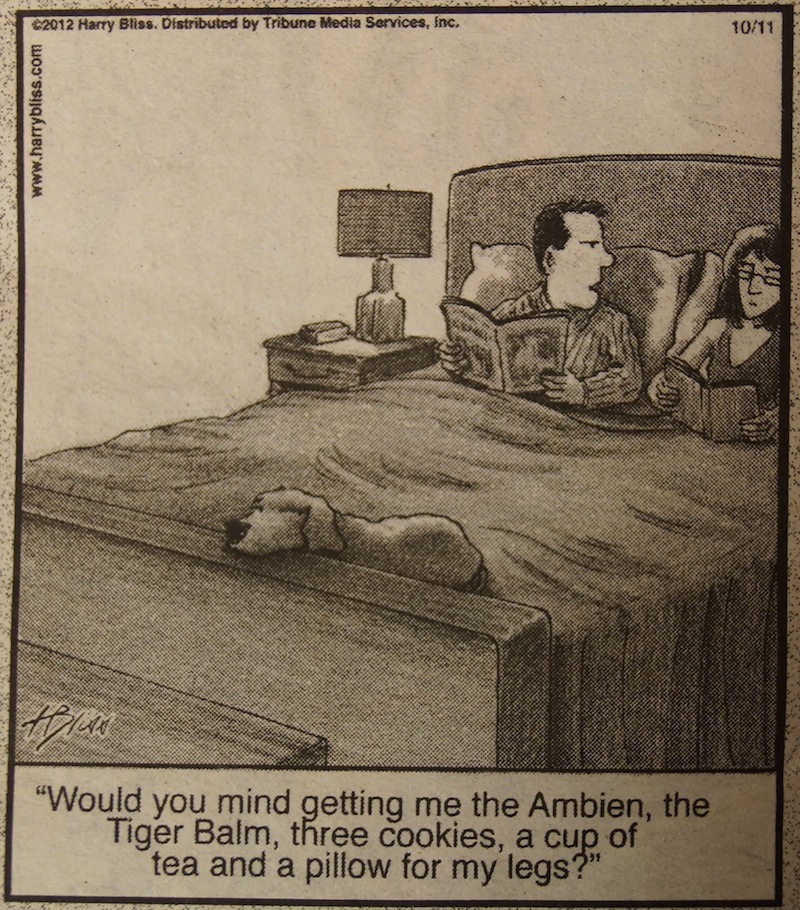Tag Archives: teaching cartoons
Teaching Cartoon: If It feels Good, Then What?
“For the mind of man is far from the nature of a clear and equal glass, wherein the beams of things should reflect according to their true incidence; nay, it is rather like an enchanted glass, full of superstition and imposture, if it be not delivered and reduced.” — Francis Bacon
Yuval Noah Harari, author of the glib but best-selling Sapiens and Homo Deus, reduces massive ideas with the efficiency of a clothes dryer fed a soaking wool sweater. For example, liberal humanism in his view simply erases all but the individual’s feeling and so it is literally for him the natural state of affairs that if something feels good one may just do it. He also asserts that, maybe, this is entirely to do to with implicitly ‘necessitarian’ algorithms.
Filed under adult learning, experiential learning, psychology, Religion, self-knowledge
Teaching Cartoon: man unable to ‘splain
Filed under adult learning, Religion, self-knowledge, sufism
A Magic Trick: Explain By Creating
In trickster’s case, how did mental fakery come to replace incarnate fakery?
It is one thing for trypanosomes to change their skins; another for Raven to become a leaf floating in spring water; another still for storytellers to have imagined Raven in the first place, or for one of us to reimagine him. Before picking these strands apart, however, we should remember that the mythology itself asks us to confuse them. Coyote stories point to coyotes teaching about the mind, the stories themselves look to predator-prey relationships for the birth of cunning. These myths suggest that blending natural history and mental phenomena is not an unthinkable conflation, but on the contrary, an accurate description of the way things are. To learn about intelligence from Coyote the meat thief is to know that we are embodied thinkers. If the brain has cunning, it has it as a consequence of appetite; the blood that lights the mind gets its sugars from the gut.
-Lewis Hyde, Trickster Makes This World: Mischief, Myth, and Art.
The subject becomes a game that hides through and in his cause from his cause, the (external) precondition laying bare the (internal) foundation. – Julie Kristeva
The tracking that any [image] instrumentalizes is an adventure that is always immediate, happening now, registering the dynamics of belief.
(adapted, substituting |image| for |text|) via, -Elaine Jahner, “Trickster Discourse and Postmodern Strategies.”)
“Play around with it, intentionally.” That would be the clue. I’m wandering around the following: participation, experience of art, play, cleverest trick.
If you could give up tricks and cleverness, this would be the cleverest trick! (version of Rumi, John LeMoyne)
An example of a clever trick in the experience of art is any expert critical opinion that is by (socially-constructed) necessity blinded to, unbounded from, the actuality of the embodied knowing which emerges from consciousness being aware and present as a matter of experiencing art, or, experiencing any ‘scene,’ so-to-speak.
Opinions like this are like standing at the end of the diving board and not wanting to dive in.
Do playful systems know that they play? [pdf]
Michael Straeubig, Plymouth University
The Philosophy of Computer Games Conference, Malta 2016
From autopoiesis to neurophenomenology: Francisco Varela’s exploration of the biophysics of being [pdf]
Antoine Lutz, et al 2003
Toward a neurophenomenology as an account of generative passages: A first empirical case study [pdf]
Antoine Lutz
LENA – Neurosciences Cognitives et Imagerie Cérébrale 2002
(*) A cybernetic model of design research: Towards a trans-domain 1 of knowing
Wolfgang Jonas, The Routledge Companion to Design Research 2014
Direction of the Possible

Man can live the most amazing things if they make sense to him. But the difficulty is to create that sense. It must be a conviction, naturally; but you find that the most convincing things man can invent are cheap and ready-made, and are never able to convince him against his personal desires and fears. — C.G. Jung, The Essential Jung: Selected Writings, p. 90
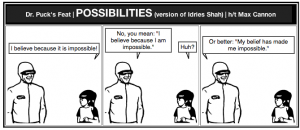
One day the Nasruddin went with some men a-fishing. They cast the net into the sea, and the Nasruddin cast himself into the net. ‘O Nasruddin,’ said they, ‘what are you about?’ ‘I imagined myself a fish,’ he answered.
Filed under adult learning, experiential learning, psychology, self-knowledge, sufism
Silence, Healing
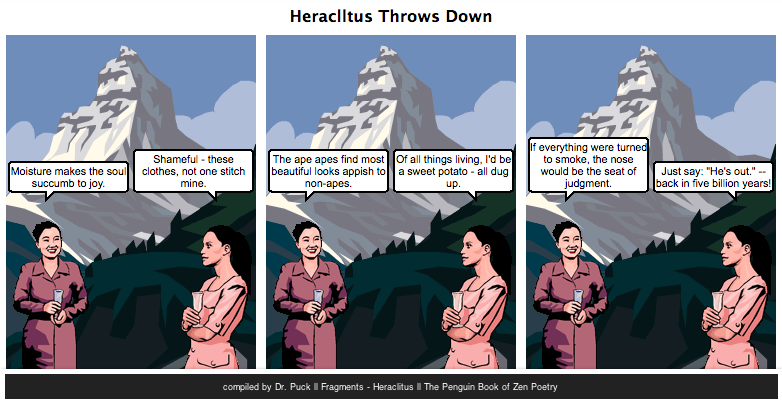
Failure does not matter in life. To a progressive person even a thousand failures do not matter. He keeps success before his view, and success is his even after a thousand failures. The greatest pity is when life comes to a standstill and does not move any further; a sensible person prefers death to such a life. (Pir Inayat Khan)
Filed under adult learning, experiential learning, philosophy, zen
And I mean every last round bit of it.
(Gaston Bachelard, the phenomenology roundness; in: Poetics of Space) I should like to give an example of an image that is outside all realistic meaning, either psychological or psychoanalytical.
Without preparing us, precisely as regards the absolute nature of the image, Michelet says that “a bird is almost completely sphericaL” If we drop the “almost,” which moderates the formula uselessly, and is a concession to a view point that would judge from the form, we have an obvious participation in Jaspers’ principle of “round being.” A bird, for Michelet, [Jules Michelet, L’oiseau, p. 291.] is solid roundness, it is round life, and in a few lines, his commentary gives it its meaning of model of being.1 “The bird, which is almost completely spherical, is certainly the sublime and divine summit of living concentration. One can neither see, nor even imagine, a higher degree of unity. Excess of concentration, which constitutes the great personal force of the bird, but which implies its extreme individuality, its isolation, its social weakness.”
In the book, these lines also appear totally isolated from the rest. One feels that the author, too, followed an image of “concentration” and acceded to a plane of meditation on which he has taken cognizance of the “sources” of life. Of course, he is above being concerned with description. Once again, a geometrician may wonder, all the more so since here the bird is considered on the wing, in its out of-doors aspect, consequently, the arrow figures could accord
here with an imagined dynamics. But Michelet seized the bird’s being in its cosmic situation, as a centralization of life guarded on every side, enclosed in a live ball, and consequently, at the maximum of its unity. All the other images, whether of form, color or movement, are stricken with relativism in the face of what we shall have to call the absolute bird, the being of round life.
The image of being-because it is an image of being that appears in this fragment by Michelet is extraordinary for the very reason that it was considered of no significance. Literary criticism has attached no more importance to it than has psychoanalysis. And yet, it was written, and it exists in an important book. It would take on both interest and meaning if a philosophy of the cosmic imagination could be instituted, that would look for centers of cosmicity.
h/t Mike Dickman for sharing the cartoon on FB
Filed under experiential learning, philosophy, psychology, self-knowledge, zen
Teaching Cartoon: Principles
It would be, of course, much better, if this occasion were celebrated with no talk at all, and if I addressed you in the manner of the ancient teachers of Zen, I should hit the microphone with my fan and leave. But I somehow have the feeling that since you have contributed to the support of the Zen Center, in expectation of learning something, a few words should be said, even though I warn you, that by explaining these things to you, I shall subject you to a very serious hoax. Alan Watts
bonus:
Alan Watts .com
Alan Watts. org
Alan Watts Facebook
Alan Watts Seminar Series (iTunes-$19.99)
Filed under philosophy, psychology, Religion, self-knowledge
Teaching Cartoon: Something
sources
(1) Miles Davis | (2) Ellen Degeneres | (3) William Hamilton | (4) Keiji Nishitani | (5) Chuang Tzu |
(6) Alan Watts (taken from You Don’t Have to Be Buddhist to Know Nothing, Joan Konner, ed.)
What can we learn from Buddhist moral psychology?
via OUPBlog | Oxford University Press’s Academic Insights for the Thinking World
Filed under adult learning, experiential learning, psychology, Religion, self-knowledge
Two Teaching Cartoons
Filed under experiential learning
Teaching Cartoon: Destiny
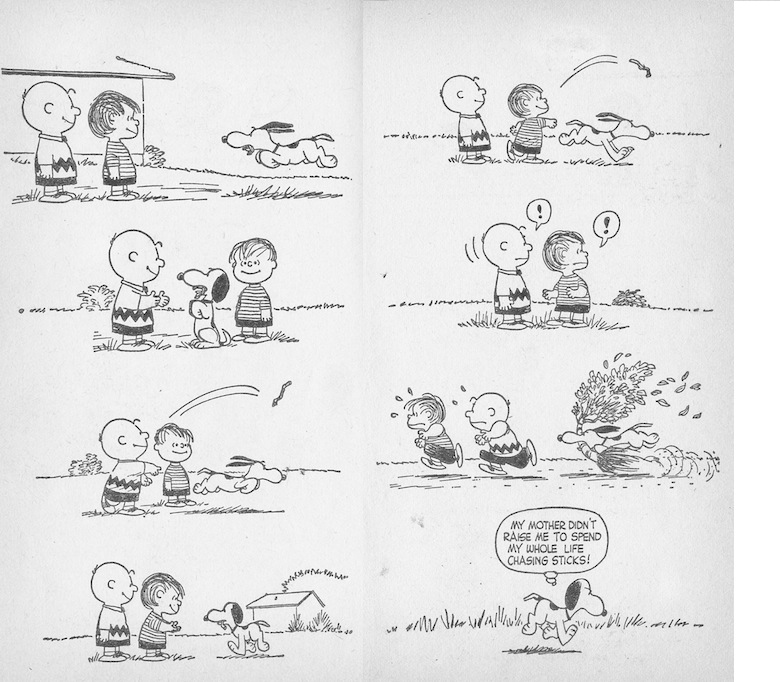
“There is no such thing as an omen. Destiny does not send us heralds. She is too wise or too cruel for that.” Oscar Wilde
A Story about Choice and Fate or Destiny — or choosing one fate for another
The King had been obsessed with fate and death for as long as he could remember. He didn’t know precisely when his intense preoccupation with these intertwined realities had begun, but begun it had, and, gradually, they had come to consume nearly every waking moment.
Some children had a favorite toy which played a central role in their early lives. Other children had an imaginary friend who kept them company through difficult times. As a boy, during adolescence, and into young adulthood, the King’s constant companions had been thoughts of fate and death.
Perhaps, the triggering events which helped precipitate his condition were the many wars that had been fought during his childhood, with so many of the Kingdom’s families losing father’s, sons, and brothers. Or, maybe, the terrible plagues which had swept through the lands, taking the lives of numerous men women and children, somehow had planted a deadly seed of another kind deep within his subconscious.
Undoubtedly, the foregoing sort of factors played contributing roles, but the King suspected that the real source of his anxieties and fears started with the mysterious stranger he had encountered one day in his room. The King had not been sure whether what took place that night was a dream or something else, but the experience had stayed with him.
Whenever he permitted his thoughts to drift in that direction, the whole scene would occupy his consciousness, like an invading force. The experience was just as vivid now as it had been some three decades ago when it first occurred.
As young boys are wont to do, he had been lying in bed, listening to the sounds of the night, thinking about the events of the day, planning what he would do tomorrow, when he heard a noise of some sort – like someone clearing his or her throat. The noise had come from the corner of his room which was always in shadows at night — even when the full moon shone through his window, as it did that evening.
All his attention was drawn to that portion of the room. He peered into the darkness of the corner, and although he couldn’t see anything, nonetheless, he felt a presence of some sort. He knew, with certainty, he was not alone.
A strange fear descended on him. He became paralyzed. (remainder of tale) h/t Bill Whitehouse.
Filed under adult learning, experiential learning
Teaching Cartoons: You Have to Have Faith. . .
(After all, the underlying social motivations haven’t changed at all.)
(Better safe than sorry.)
Bonus reading: Tradition in a Free Society: The Fideism of Michael Polanyi and the Rationalism of Karl Popper
by Struan Jacobs (pdf)
Filed under adult learning, humor
Teaching Cartoons: On Context
Calvin will be surprised when the test comes back.
This replicates a classic form of a lesson on ‘precision.’
Filed under adult learning, experiential learning
It’s Cold Outside + Teaching Cartoon
Even yours truly, being a ‘nary a Christian,’ and by reputation being also a mildly notorious Christmas season curmudgeon, can warm up to this video.
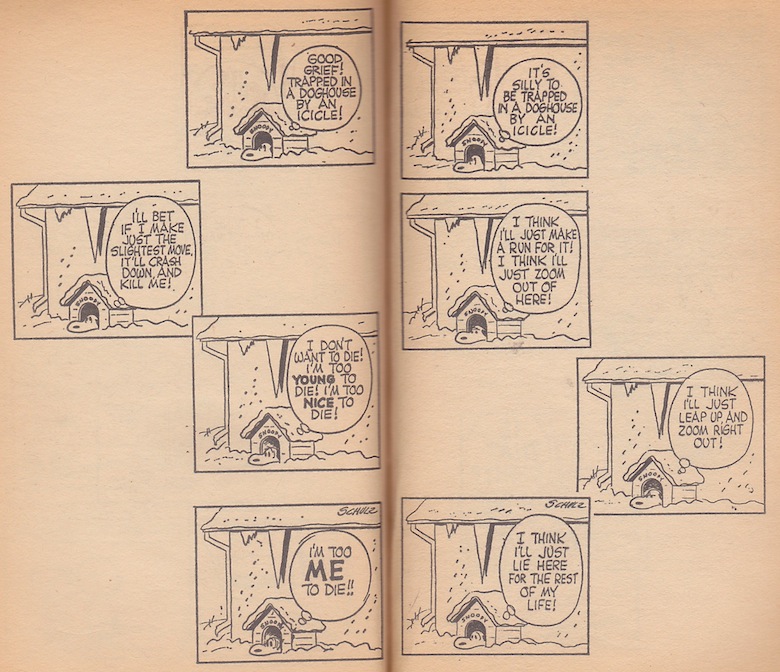
“I’m too ME to die.” is typical Snoopy, in Snoopy’s ‘French’ mode. These two cartoons face each other down.
Filed under adult learning, experiential learning
Teaching Cartoon: Two On ‘Timing’ & a Tale
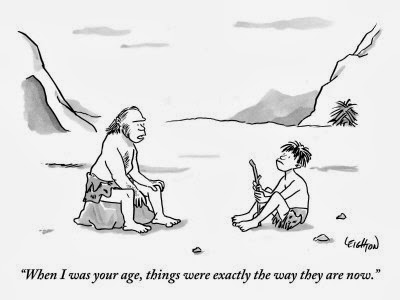
Only Enough Time to Get Where You Stand, Right
The captain of a ship received a message one night, “Change your direction 15 degrees North to avoid collision”.
A little indignant, the captain replied, “I am the captain of a large ship and recommend you divert 15 degrees South”.
The captain received the reply, “We are a lighthouse”.
Filed under experiential learning
Teaching Cartoons: Instrumentality 1 & 2
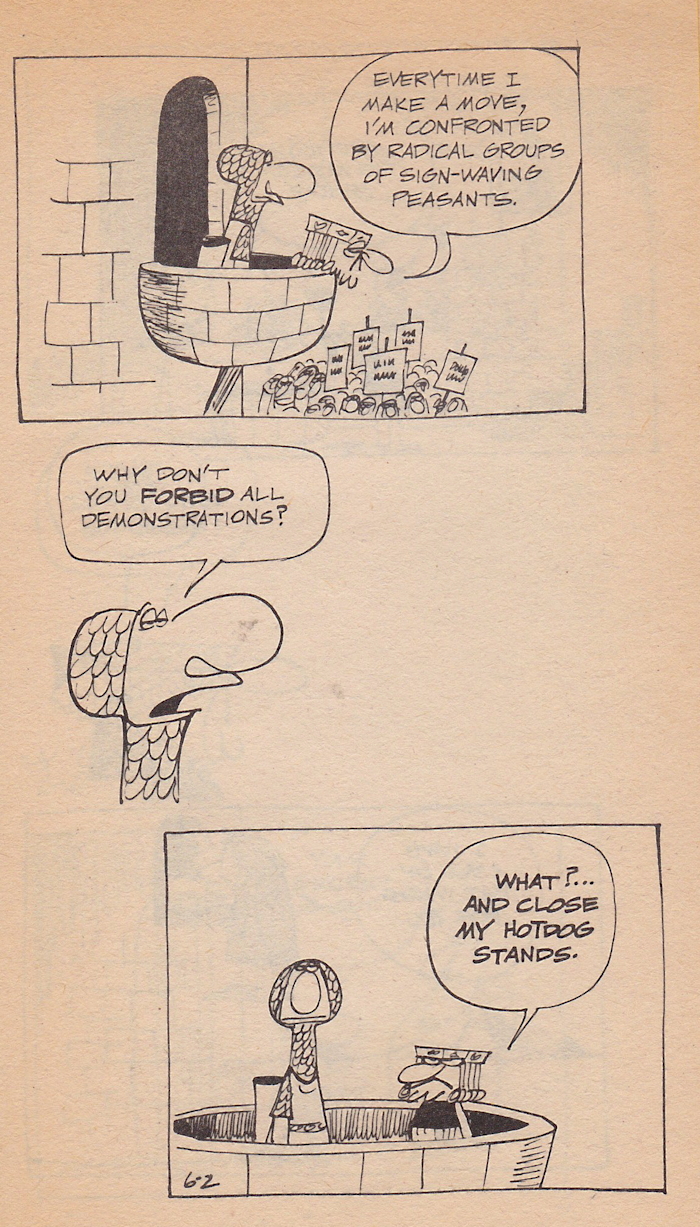
Samurai Prayer
I HAVE NO PARENTS;
I MAKE THE HEAVENS AND EARTH MY PARENTS.
I HAVE NO HOME;
I MAKE AWARENESS MY HOME
I HAVE NO LIFE OR DEATH;
I MAKE THE TIDES OF MY BREATHING MY LIFE AND DEATH.
I HAVE NO DIVINE POWER;
I MAKE HONESTY MY DIVINE POWER.
I HAVE NO MEANS;
I MAKE UNDERSTANDING MY MEANS.
I HAVE NO MAGIC SECRETS;
I MAKE CHARACTER MY MAGIC SECRET.
I HAVE NO BODY;
I MAKE ENDURANCE MY BODY.
I HAVE NO EYES;
I MAKE THE FLASH OF LIGHTNING MY EYES.
I HAVE NO EARS;
I MAKE SENSIBILITY MY EARS.
I HAVE NO LIMBS;
I MAKE PROMPTNESS MY LIMBS.
I HAVE NO STRATEGY;
I MAKE CLARITY MY STRATEGY.
I HAVE NO DESIGNS;
I MAKE INTUITION MY DESIGN.
I HAVE NO MIRACLES;
I MAKE RIGHT-ACTION MY MIRACLES.
I HAVE NO PRINCIPLES;
I MAKE NO-AVERSION MY PRINCIPLE.
I HAVE NO TACTICS;
I MAKE EMPTINESS AND FULLNESS MY TACTICS.
I HAVE NO TALENTS;
I MAKE READY WIT MY TALENT.
I HAVE NO FRIENDS;
I MAKE MY MIND MY FRIEND.
I HAVE NO ENEMY;
I MAKE CARELESSNESS MY ENEMY.
I HAVE NO ARMOR;
I MAKE BENEVOLENCE AND RIGHTEOUSNESS MY ARMOR.
I HAVE NO CASTLE;
I MAKE IMMOVABLE-MIND MY CASTLE.
I HAVE NO SWORD;
I MAKE ABSENCE OF SELF MY SWORD.
Samurai Prayer
Filed under adult learning

